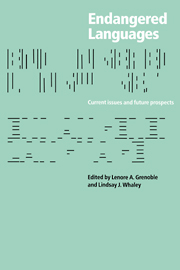Book contents
- Frontmatter
- Contents
- Preface
- List of abbreviations and symbols
- Part I General issues
- Part II Language-community responses
- Part III What is lost: language diversity
- Part IV Mechanisms of language loss
- 11 Impact of language variation and accommodation theory on language maintenance: an analysis of Shaba Swahili
- 12 A way to dusty death: the Matrix Language turnover hypothesis
- 13 Copper Island Aleut: a case of language “resurrection”
- Appendix
- References
- Index of languages
- Index of names
- General index
11 - Impact of language variation and accommodation theory on language maintenance: an analysis of Shaba Swahili
Published online by Cambridge University Press: 05 June 2012
- Frontmatter
- Contents
- Preface
- List of abbreviations and symbols
- Part I General issues
- Part II Language-community responses
- Part III What is lost: language diversity
- Part IV Mechanisms of language loss
- 11 Impact of language variation and accommodation theory on language maintenance: an analysis of Shaba Swahili
- 12 A way to dusty death: the Matrix Language turnover hypothesis
- 13 Copper Island Aleut: a case of language “resurrection”
- Appendix
- References
- Index of languages
- Index of names
- General index
Summary
Introduction
In recent years, the dialect of Swahili spoken in Shaba, Zaire, has been one of the few African languages that have raised a certain level of curiosity in the field of pidgin and Creole studies, in large part because Shaba Swahili (Sh.S.) exhibits many differences when compared to other Swahili subdialects spoken in East Africa (and eastern Zaire). These variations have generally been considered as instances of decay, colloquialism, corruption, and even a threat to the “homogeneous nature” of the Swahilip-speaking community.
However, one of the areas for which Sh.S. has not been studied is its usefulness for our understanding of the process of linguistic maintenance or language revitalization. In other words, since Sh.S. has generally been considered as a less prestigious variant, there has been a concerted effort to bolster the more prestigious subdialect, Standard Sh.S. These efforts, which have generally been witnessed in churches, schools, some courts, and in the local and national media, have proven to be unsuccessful. The “ordinary” or less prestigious dialect is still very strong and is thriving in all spheres of the Shabian society.
In this chapter, I will not discuss the policies put in place to bolster the Standard Subdialect. I will rather concentrate on the study of some of the natural, linguistic, political, attitudinal, psychological, and social factors that have contributed to the entrenchment of a subdialect which is naturally more prominent than the more prestigious subdialect, namely Standard Sh.S.
- Type
- Chapter
- Information
- Endangered LanguagesLanguage Loss and Community Response, pp. 261 - 288Publisher: Cambridge University PressPrint publication year: 1998
- 1
- Cited by



